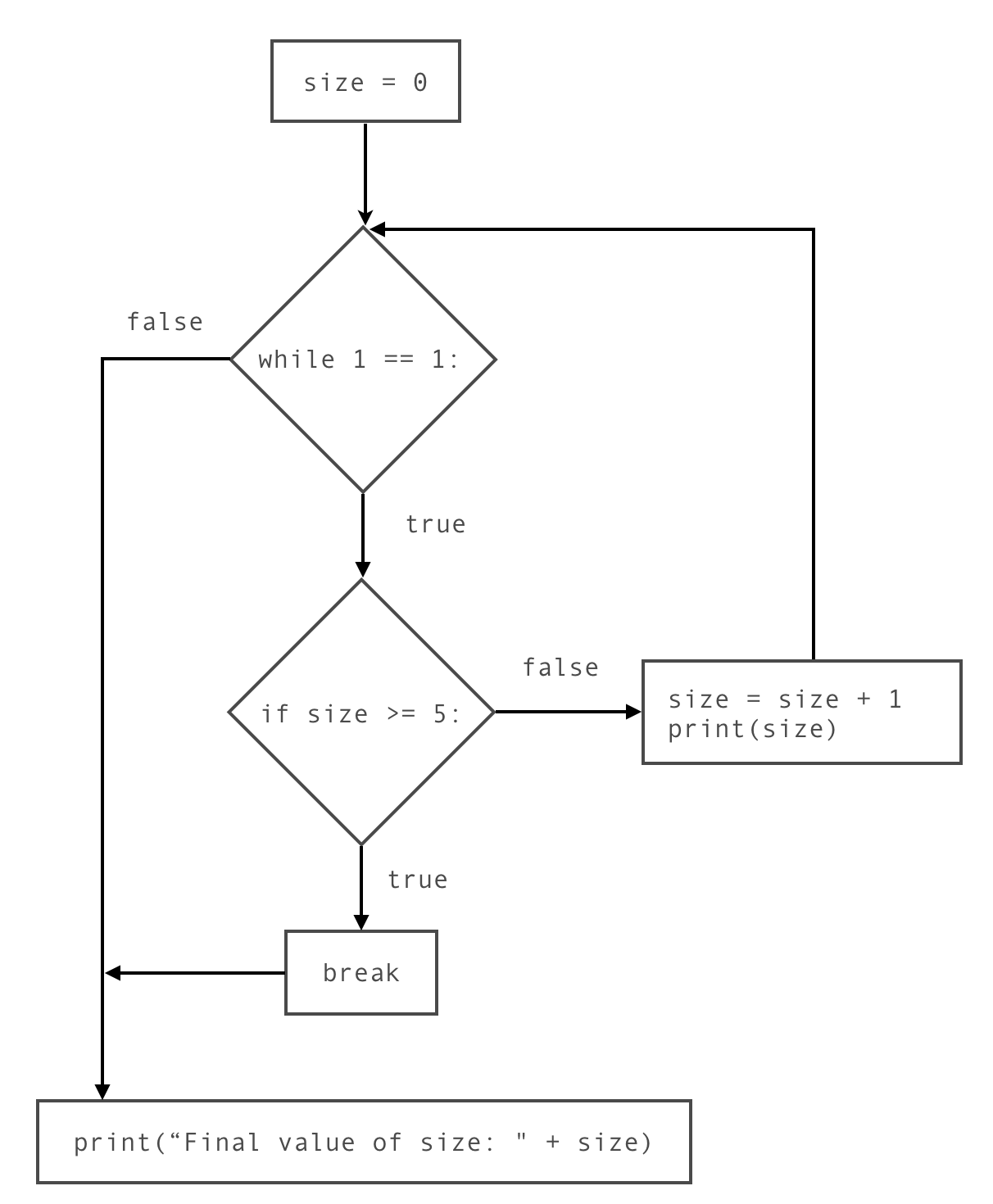 Teacher note: Misconception - While exits immediately¶
Teacher note: Misconception - While exits immediately¶
Some students hold the misconception that the while loop exits immediately after its condition becomes false. For instance:
In this example, size becomes 5 at the last iteration of the loop, but before its value is printed. A student who held this misconception would predict that the output of this program would be as follows, leaving out the 5:
11
22
33
44
5Final value of size: 5
Correct understanding The correct behavior of while loops is that its condition is only checked after the entire loop body is executed.
This flowchart illustrates how the above example is executed:

Figure 1: While loop flowchart.¶
Stepping through this flowchart might help students understand the execution flow through the while loop.
What is the correct output of the program, then? Practice tracing through the flowchart and enter your answer here:
Alternative: Infinite loops with break¶
If your students are having difficulty understanding the execution flow of the while loop, here’s an alternative way of structuring this loop that has been shown to be much easier for students to grasp:
1while 1 == 1:
2 if <condition>: # replace <condition> with the condition for exiting the loop
3 break
4 <loop body> # replace <loop body> with the loop body
It’s an infinite loop with an explicit break statement if a certain condition is true. Let’s break that statement down:
Infinite loop You’ll recognize the infinite loop from a previous section. While normally we try to avoid infinite loops, in this case it is safe to use since we also have the explicit break.
break statement When a break statement is encountered inside a loop, it causes execution to exit the loop, skipping the rest of the loop body. In the following program, the last two lines of the loop body are never executed, because the loop exits at the break statement.
Question: If this is an infinite loop, why is the first line only printed one time?
Answer: The loop does not repeat because of the break statement, so the first line is only executed once.
Now that we’ve considered these individual pieces on their own, let’s put them back together:
1while 1 == 1:
2 if <condition>: # replace <condition> with the condition for exiting the loop
3 break
4 <loop body> # replace <loop body> with the loop body
This is an infinite loop with an explicit break statement if a certain condition is true.
Back to our example Here is the example above, structured using an infinite loop:
Run the above program. Inspect the output to check whether this new loop is indeed identical to our original while loop.
Code lens walkthrough
Before watching this video, walk through the code by hand and answer these questions:
How many times is the line
while 1 == 1evaluated?How many times is the line
if size >= 5evaluated?How many times is the line
breakevaluated?How many times is the line
print(size)evaluated?
We discuss the answers at the end of the video.
Here’s the flowchart that corresponds to this new structure:

Figure 2: Flowchart for infinite while-loop with break.¶
As above, practice stepping through this flowchart to see the execution flow.
Flowchart: step-through
In summary, structuring loops this way requires an infinite loop, plus the condition to stop repeating the body. That condition goes in the if statement (containing the break ) immediately after the while statement, followed by the loop body (the code you want to repeat).
Why is this way of structuring while loops better? Because it makes the point at which the loop exits explicit.
In the original version, execution returns to the top of the loop after the body is executed, but if the condition is false, execution then jumps to after the end of the body to exit the loop. This exit of the loop is implied, not stated.
In the infinite-loop version, however, the fact that the condition is checked at every repeat of the loop is spelled out, and the explicit break statement clearly indicates the point at which the loop exits.